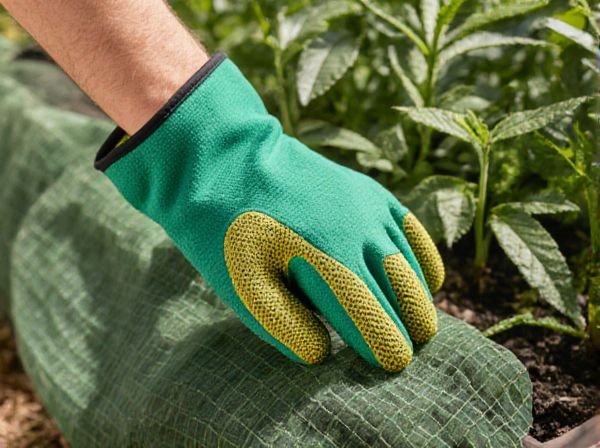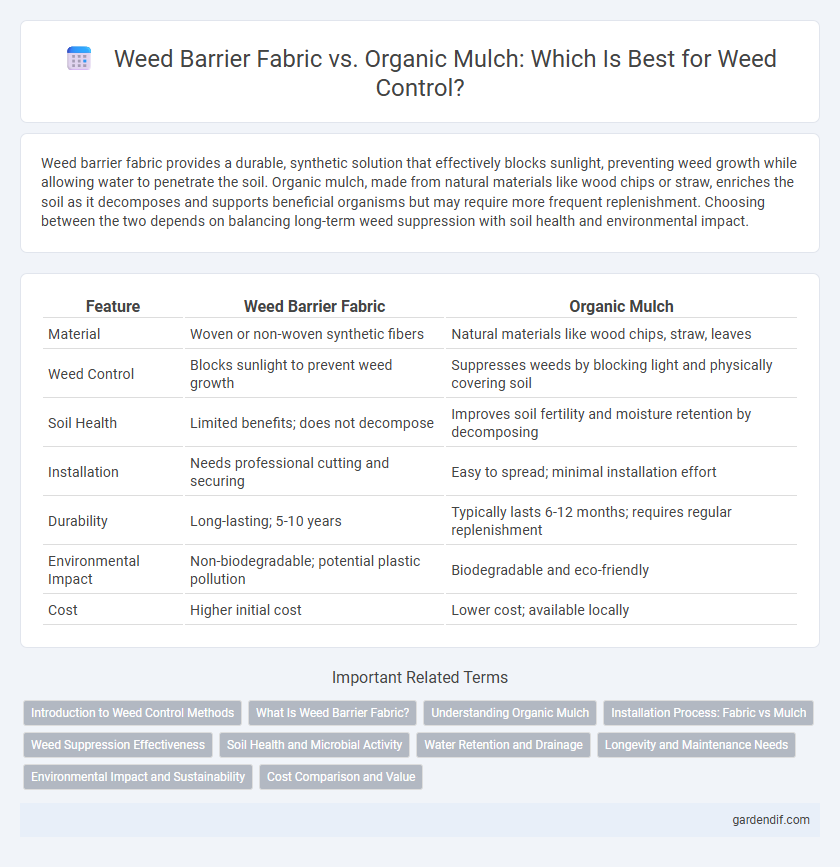
Weed barrier fabric vs Organic mulch Illustration
Weed barrier fabric provides a durable, synthetic solution that effectively blocks sunlight, preventing weed growth while allowing water to penetrate the soil. Organic mulch, made from natural materials like wood chips or straw, enriches the soil as it decomposes and supports beneficial organisms but may require more frequent replenishment. Choosing between the two depends on balancing long-term weed suppression with soil health and environmental impact.
Table of Comparison
| Feature | Weed Barrier Fabric | Organic Mulch |
|---|---|---|
| Material | Woven or non-woven synthetic fibers | Natural materials like wood chips, straw, leaves |
| Weed Control | Blocks sunlight to prevent weed growth | Suppresses weeds by blocking light and physically covering soil |
| Soil Health | Limited benefits; does not decompose | Improves soil fertility and moisture retention by decomposing |
| Installation | Needs professional cutting and securing | Easy to spread; minimal installation effort |
| Durability | Long-lasting; 5-10 years | Typically lasts 6-12 months; requires regular replenishment |
| Environmental Impact | Non-biodegradable; potential plastic pollution | Biodegradable and eco-friendly |
| Cost | Higher initial cost | Lower cost; available locally |
Introduction to Weed Control Methods
Weed barrier fabric provides a physical barrier that blocks sunlight and prevents weed growth by restricting seed germination, making it a durable and low-maintenance option for long-term weed control. Organic mulch, composed of natural materials like wood chips or straw, suppresses weeds by shading the soil, retaining moisture, and enriching soil health through decomposition. Both methods play crucial roles in integrated weed management by balancing effectiveness, soil benefits, and environmental impact.
What Is Weed Barrier Fabric?
Weed barrier fabric is a durable, permeable material designed to block sunlight and prevent weed growth while allowing water and air to reach the soil. Unlike organic mulch, which decomposes and enriches the soil, weed barrier fabric creates a long-lasting physical barrier that requires less frequent replacement. This fabric is commonly made from woven polypropylene or polyester and is often used in landscaping and gardening for effective weed control.
Understanding Organic Mulch
Organic mulch, composed of natural materials such as wood chips, leaves, and straw, enhances soil fertility by decomposing and enriching the soil with essential nutrients. This mulch type improves moisture retention, reduces soil erosion, and supports beneficial microbial activity, fostering healthier plant growth. Compared to weed barrier fabric, organic mulch offers a sustainable, eco-friendly weed control solution while promoting long-term soil health and biodiversity.
Installation Process: Fabric vs Mulch
Weed barrier fabric installation involves unrolling the material directly over the soil, securing it with landscape staples or pins, and cutting holes for plants, creating a physical barrier that blocks sunlight and prevents weed growth. Organic mulch installation requires spreading a 2-4 inch thick layer of wood chips, straw, or compost over the soil surface, which suppresses weeds by blocking light but also adds nutrients as it decomposes. While fabric offers a longer-lasting, maintenance-free solution, organic mulch requires periodic replenishment and can improve soil health over time.
Weed Suppression Effectiveness
Weed barrier fabric provides superior long-term weed suppression by creating a physical barrier that blocks sunlight, preventing weed seed germination and growth. Organic mulch, while improving soil health and moisture retention, typically requires regular replenishment and may allow some weed penetration over time. Combining weed barrier fabric with a layer of organic mulch maximizes weed suppression by blending physical obstruction with natural soil enrichment.
Soil Health and Microbial Activity
Weed barrier fabric effectively suppresses weeds by blocking sunlight but can limit water and air flow, potentially reducing soil microbial activity and overall soil health. Organic mulch promotes soil health by decomposing and enriching the soil with organic matter, which enhances microbial activity and nutrient cycling. Choosing organic mulch supports a thriving soil ecosystem, while weed barrier fabric may create a less biologically active environment.
Water Retention and Drainage
Weed barrier fabric enhances water retention by preventing soil evaporation while allowing excess water to drain through its permeable structure, promoting healthy root systems. Organic mulch improves moisture retention by absorbing and gradually releasing water, yet it may slow drainage depending on thickness and composition. Both methods aid in water management, but weed barrier fabric offers more consistent drainage control compared to organic mulch's variable permeability.
Longevity and Maintenance Needs
Weed barrier fabric offers superior longevity, often lasting up to 10 years without needing replacement, compared to organic mulch that decomposes within a single growing season and requires annual replenishment. The synthetic, impermeable nature of weed barrier fabric significantly reduces weed growth and limits water evaporation, lowering maintenance demands. Organic mulch improves soil health by adding nutrients as it breaks down, but its maintenance needs are higher due to frequent reapplication and potential pest attraction.
Environmental Impact and Sustainability
Weed barrier fabric reduces the need for chemical herbicides, minimizing soil and water contamination, but is typically made from non-biodegradable synthetic materials that can persist in the environment. Organic mulch, composed of natural materials like wood chips or straw, enriches soil health by decomposing and returning nutrients, promoting long-term sustainability and biodiversity. While organic mulch demands more frequent replacement, its eco-friendly composition significantly lowers environmental impact compared to plastic weed barriers.
Cost Comparison and Value
Weed barrier fabric typically costs between $0.10 and $0.40 per square foot, offering long-lasting weed suppression and reduced maintenance expenses over time. Organic mulch, priced around $1 to $3 per bag covering 2-3 square feet, requires frequent replenishment but enhances soil fertility and moisture retention. While weed barrier fabric presents a higher upfront investment, organic mulch delivers added ecological benefits, making cost-effectiveness dependent on long-term gardening goals and priorities.
Weed barrier fabric vs Organic mulch Infographic

 gardendif.com
gardendif.com